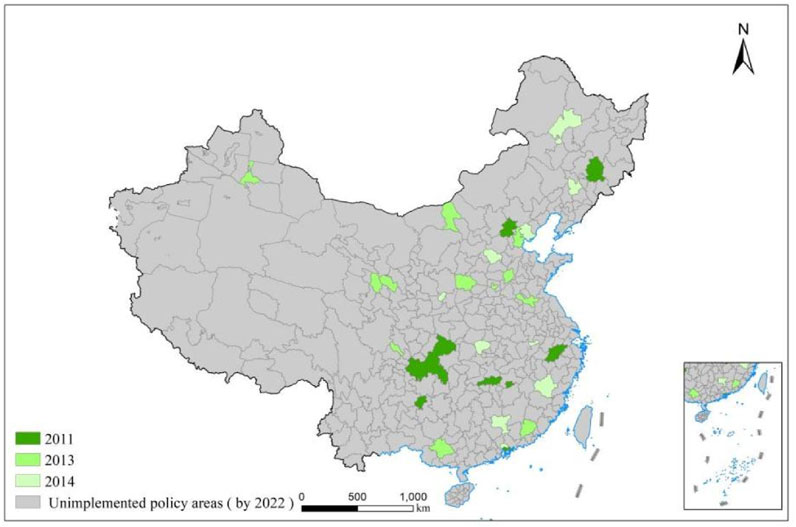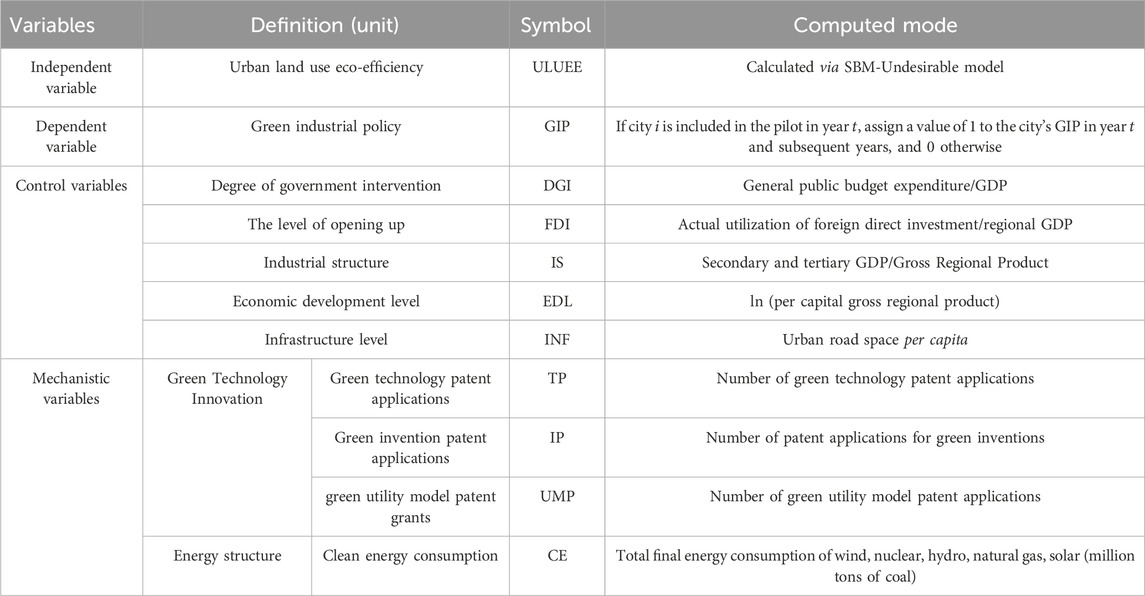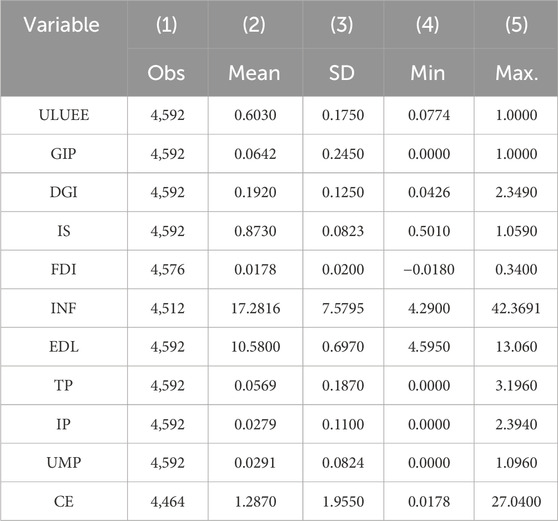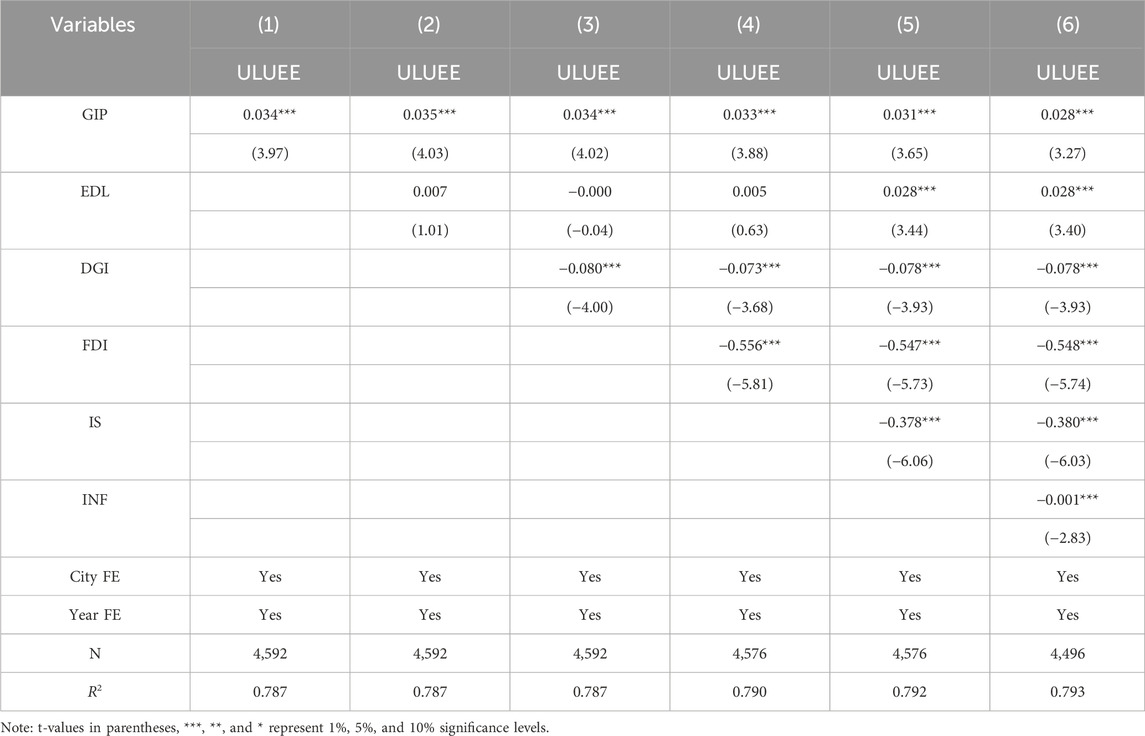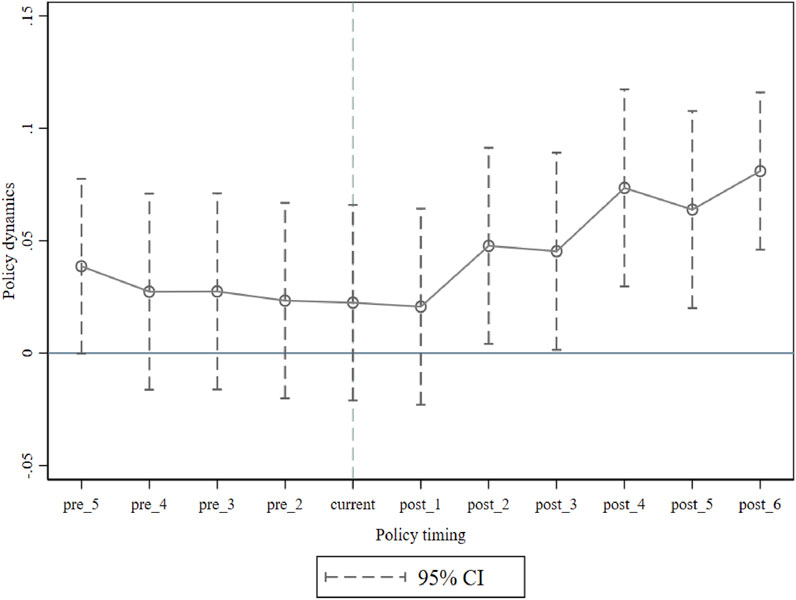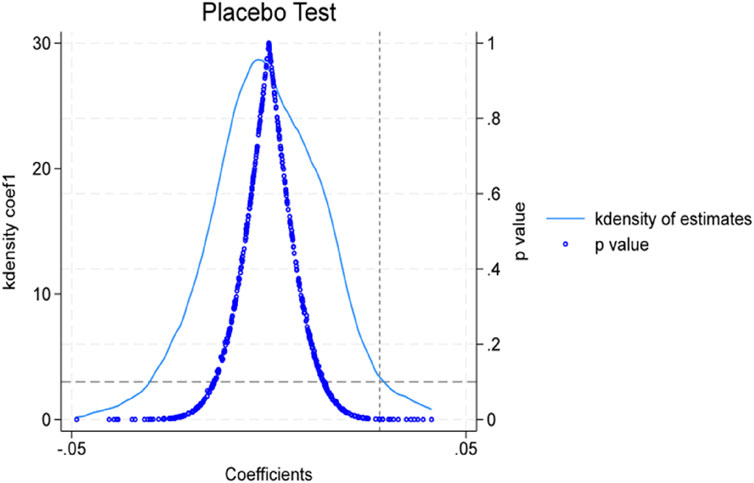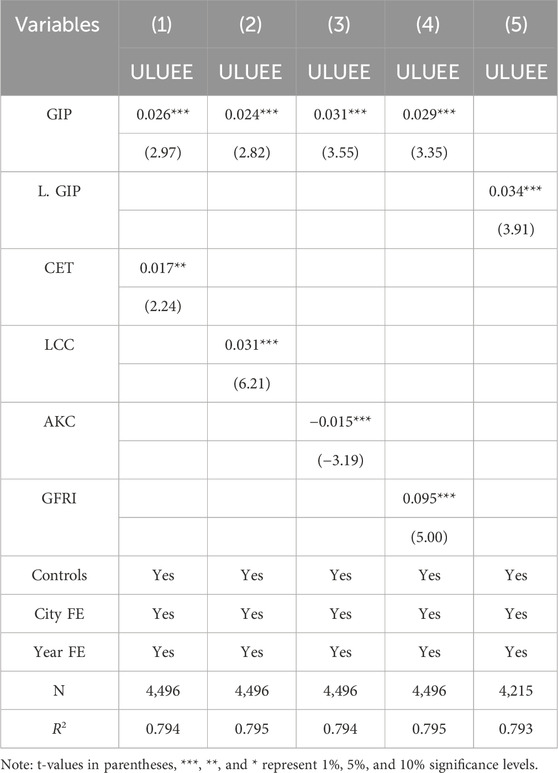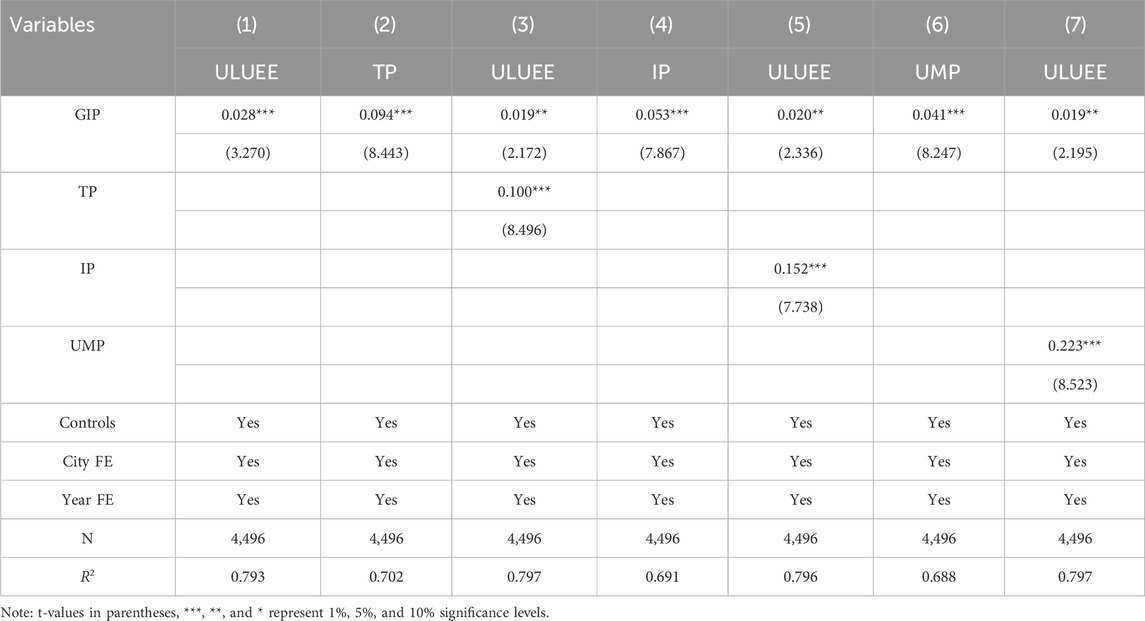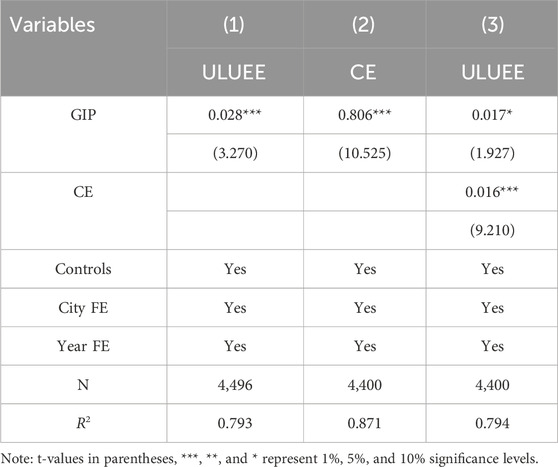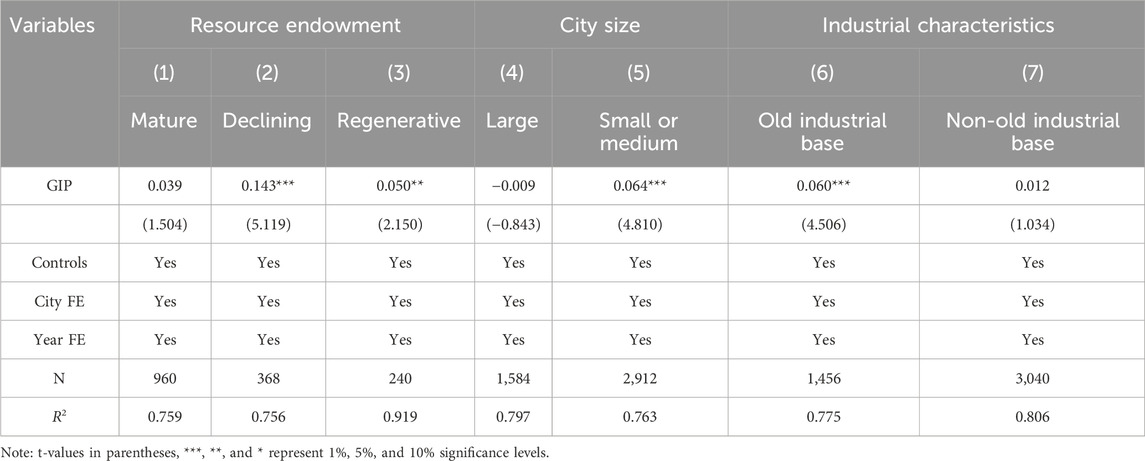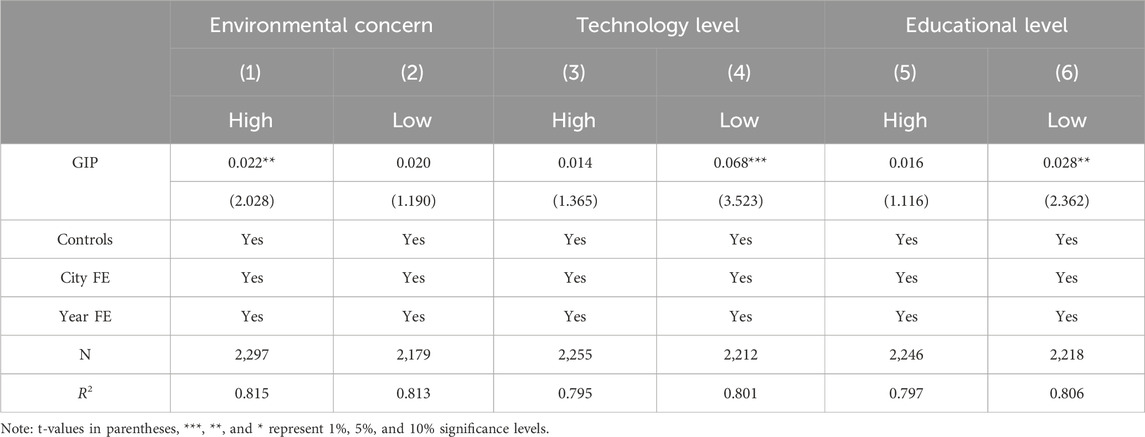- 1Xi’an University of Architecture and Technology Huaqing College, Xi’an, China
- 2School of Economics, Minzu University of China, Beijing, China
- 3School of Marxism, Guangxi University, Nanning, China
Green industrial policy (GIP) is a crucial instrument for driving a green, low-carbon transition. While prior research has predominantly examined its role in enhancing firms’ green performance, its potential contribution to the ecological transformation of land use has been largely overlooked. This study uses panel data from 287 prefecture-level cities in China over the period 2007–2022 and employs a multi-period difference-in-differences (DID) framework, leveraging the quasi-natural experiment provided by the “Comprehensive Demonstration Cities for Energy Saving and Emission Reduction” pilot program, to investigate the impact of green industrial policy on urban land use eco-efficiency (ULUEE). Our findings show that GIP significantly improves ULUEE, and this result remains robust across various robustness checks. Mechanism analysis indicates that the policy stimulates urban green technological innovation and optimizes the energy consumption structure, both of which contribute to higher ULUEE. Heterogeneity analysis further reveals that the policy’s positive effects are especially pronounced in resource-declining cities, small and medium-sized cities, old industrial base cities, cities with lower levels of scientific and educational development, and cities where public environmental concern is greater. These results imply that the ecological benefits of GIP are broadly inclusive, albeit contingent upon the public’s environmental awareness. By examining GIP through the lens of land use, this paper uncovers its ecological value and offers a novel pathway for enhancing ULUEE.
1 Introduction
Over the past 40 years of reform and opening up, China has achieved remarkable economic growth through substantial resource investment and extensive industrial expansion. However, this has resulted in a development model marked by elevated energy consumption and significant emissions, facilitating short-term economic acceleration while confronting the long-term challenge of substantial ecological costs. In 2006, China overtook the United States to become the world’s foremost carbon emitter (Zhang et al., 2017). Figure 1 illustrates the ongoing increase in carbon emissions and overall energy consumption within China’s prefecture-level administrative units. China’s coal usage is 57.64% of total energy consumption, far surpassing that of the European Union (11.18%) and the United States (11.98%) (Zhao et al., 2022). Energy consumption per unit of GDP is 1.5 times the global norm, while energy intensity is 1.3 times the global average (Zhang et al., 2020), underscoring the dual challenge of energy use efficiency. This development pattern exhibits a dual negative impact in the spatial dimension. The extraction, transportation, and transformation of fossil energy sources like coal and oil result in ecological land encroachment, exacerbation of land pollution, and fragmentation of biological habitats, thereby impairing the ecosystem’s self-repair capabilities (Haddad et al., 2015). Conversely, the unchecked growth of energy-intensive enterprises has exacerbated the inefficiency of industrial land utilization and contributed to issues of urban sprawl and irrational spatial organization (Seto et al., 2012), resulting in a misalignment of urban land resources. Inefficient land utilization consequently escalates energy consumption intensity due to redundant infrastructure development and heightened energy transmission losses. Land use eco-efficiency (ULUEE) has emerged as a crucial factor in resolving the development dilemma, encompassing not only the economic productivity of land resources but also influencing the carbon sequestration capacity of ecosystems and their potential for spatial transformation. The aforementioned model of high energy consumption and elevated emissions, along with the consequent low ecological efficiency in land use, can be largely attributed to the traditional industrial policy framework of the past. This framework has been characterized by a focus on scale expansion and cost competition (Rolfo and Calabrese, 2003). Such an orientation has led to the excessive development of resource-intensive industries while failing to effectively internalize environmental costs or promote a transition towards greener practices. Against this backdrop, ULUEE plays a crucial role in balancing economic growth with ecological protection. They are essential for promoting the green transformation of industries and improving ULUEE. The core idea is to redirect production factors from high-carbon, low-efficiency sectors to green, innovative ones through policy interventions, fundamentally transforming the industrial base and economic incentives that influence ULUEE. However, there is a lack of clear evidence about how it works and what results it produces. Global climate governance has reached a phase of heightened action intensity. As a responsible developing nation, China must navigate the dual challenges of economic development, land resource efficiency, and ecological protection through innovative green industrial policies and reforms in land governance. It is essential to identify a practical approach that reconciles developmental rights with environmental rights, which is crucial not only for its own ecological civilization but also for broader ecological considerations. This is not only relevant to the development of its own ecological civilization but also has a significant impact on the equity and efficacy of global climate regulation (Huang et al., 2025). So, under the dual-carbon goal, explaining how green industrial policy (GIP) affects land use eco-efficiency can help balance conservation and development.
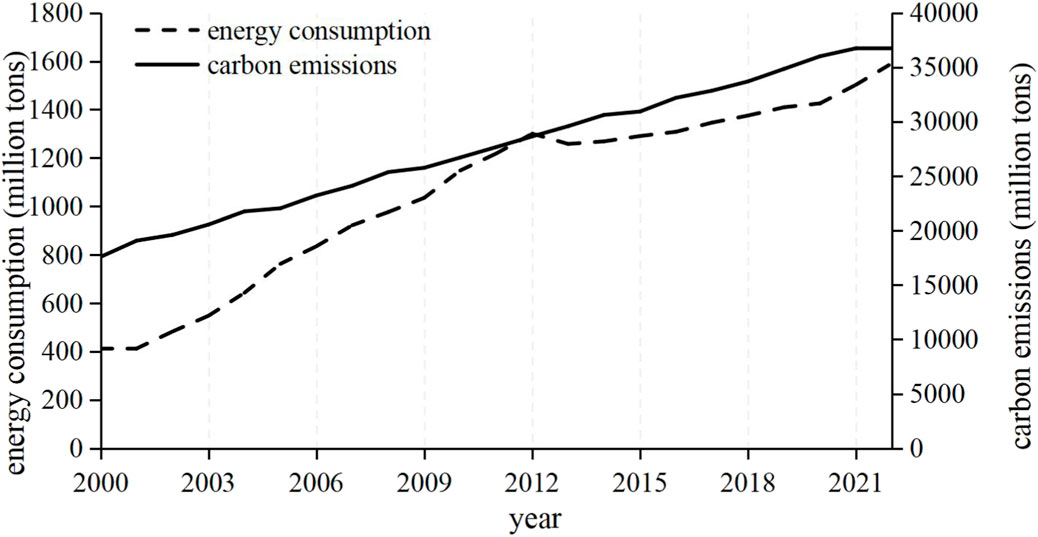
Figure 1. Variations in aggregate carbon emissions and overall energy usage in urban areas of China.
In recent years, the emergence of green development has led to a growing focus on ULUEE. ULUEE involves analyzing the input and output systems of various resources in urban areas, guided by sustainable urban development principles (Tan et al., 2021). As a key indicator for measuring the coordination of urban human-environment systems, this concept establishes a “input-process-output” framework: At the input end, it focuses on the intensity of production factors such as land, capital, and labor; at the process end, it emphasizes optimizing industrial layout and applying ecological technologies; at the output end, it balances economic value creation, social welfare enhancement, and ecological impact. Tan et al. (2021) characterize it as a thorough delineation of the synergistic optimization of the urban system concerning resource inputs, economic outputs, and environmental repercussions. While research on the determinants of ULUEE is very extensive, it needs further expansion (Chen Q. et al., 2023). The primary issues of ULUEE in the present study stem from the natural environment, economic development (Wang, 2023), industrial structure (Chang et al., 2023), regional economic collaboration, and the degree of urbanization (Zhang et al., 2021). Vergurg et al. examined ULUEE through ecological and sociological lenses (Verburg et al., 2010), whereas Halleux et al. examined the determinants of ULUEE in the Netherlands, Poland, and Belgium (Halleux et al., 2012). Moreover, scant work has concentrated on the function of GIP within this context. Given the adverse externality of pollution, the beneficial externality of governance, and the public goods characteristics of ecosystems, policy direction is paramount in the management of environmental pollution and the mitigation of climate change (Chu et al., 2024). Dependence only on market systems presents difficulties. The concept of central-local teamwork in governance emphasizes the need for collaboration between central and local governments on green industry policies and environmental management. GIP is crucial for this cooperation, providing guidance, regulation, incentives, and synergy to achieve dual-carbon goals and restructure the economic framework (Anzolin and Lebdioui, 2021).
GIP is a pertinent sectoral strategy that employs environmental objectives to shape the methods and framework of economic production (Busch et al., 2018). This is a set of governmental interventions designed to facilitate the transition of economic structural objectives towards green and sustainable development, primarily aimed at expediting the transformation and enhancement of green production (Matsuo et al., 2019). Unlike traditional industrial policies that primarily focus on economic growth, the green industrial policy framework considers environmental costs by strategically planning institutions, allocating resources, and guiding the market. This approach directs resources toward areas that generate lower carbon emissions. The carbon tax mechanism can restrain the uncontrolled growth of high-carbon businesses through price leverage (Metcalf, 2009), while the renewable energy subsidy program can expedite the commercialization of clean technology (Grubb et al., 2021). This policy change aims to adjust economic growth rewards by prioritizing ecological value in development assessments. Global evidence shows that effectively implementing green technologies can reduce costs of the low-carbon transition while creating benefits such as green jobs and promoting technical innovation (Dulal and Akbar, 2013). GIP primarily serves to direct industrial development by incorporating ecological principles into regulatory frameworks via instruments such as differentiated access standards, innovation subsidies, and incentives for low-carbon technology transformation (Kou et al., 2023), while also offering a cost-sharing mechanism and market expectation guidance for enterprises undergoing green transformation. The energy conservation and emission reduction policy is a key part of GIP, helping to shift the economy towards being more environmentally friendly by encouraging less resource use and pollution, while also promoting the development of clean technologies and green industries. The energy conservation and emission reduction policy depends on local governments to lead and cities to implement it, utilizing financial incentives to encourage investment. This strategy aims to accelerate innovation and economic changes to achieve emission reduction targets. Most current research looks at GIP, overall productivity, technical innovation and development (Harrison et al., 2017), and the green transformation of industries (Rogge and Reichardt, 2016), but it overlooks how GIP affects ULUEE.
This study analyzes 287 prefecture-level cities from 2007 to 2022 to clarify how GIP drives ULUEE, viewed through the lens of fiscal intervention. By constructing a difference-in-difference model, the study focuses on the transmission effect of GIP on ULUEE through green technology innovation and energy system optimization and subsequently assesses its eco-governance value. It is found that GIP makes a significant contribution to ULUEE, which remains valid following various robustness tests. Further analysis reveals that GIP improves the level of urban green technological innovation and thus enhances ULUEE. Heterogeneity analysis reveals that GIP has a greater effect on ULUEE in resource-declining cities, small and medium-sized cities, and cities in old industrial bases, which indicates that the release of the ecological value of GIP relies on a certain urban foundation, and this effect is greater in regions with high environmental concerns, confirming the “social consensus-policy effectiveness” multiplier. Additionally, this effect is more pronounced in cities with lower levels of science and technology as well as education, suggesting that GIP can help compensate for deficiencies in urban science and education to enhance ULUEE. This study improves our understanding of how GIP can positively impact the environment, shows how these policies can make urban land use more eco-efficient, and provides practical ideas for making cities greener and better for the environment.
This paper makes several significant contributions to the field, which are outlined as follows. First, this study combines GIP with the analysis of how land use can be more eco-efficient, filling a gap in research about how ecological changes happen in land resource management. The current literature predominantly examines the influence of macroeconomic factors, such as economic growth (Lambin and Meyfroidt, 2011) and technological advancement (Villoria, 2019), but there are relatively few studies on how GIP can improve ecological efficiency by changing the behavior of land use subjects. GIP can effectively promote the green transformation of industries through various policy instruments. The dedicated fund for green industry development, established by central and local governments, reduces the financial burden on enterprises. It prioritizes clean energy equipment production, recycling economy industrial parks, and low-carbon technology research and development (Khattak et al., 2022). This initiative promotes a collaborative management model of “central guidance—local synergy” to accelerate the ecological restoration of contaminated land through policy leverage. This effect enhances carbon sequestration per unit of industrial land and achieves synergy between ecological function restoration and resource utilization. Furthermore, GIP can stimulate market innovation through varied industrial orientation, thereby providing sustained impetus for enhancing ULUEE. This paper thoroughly explores why green industrial policy is important and how it helps improve ULUEE, explaining how it works and providing new ideas for research in this area.
Second, this paper undertakes a more comprehensive analysis of the ecological benefits associated with GIP and examines the pivotal role of government in facilitating ecological transformation. This study elucidates the potential of GIP through the lens of ULUEE. The academic community generally pays less attention to the role of GIP in green transition and sustainable development. Furthermore, research on ecological efficiency predominantly focuses on green finance (Taghizadeh-Hesary and Yoshino, 2019), green credit (Xu et al., 2023) and green innovation, overlooking the critical role of GIP in enhancing ULUEE and its relevance to green transition. In addition, existing studies on GIP mostly focus on its environmental benefits, such as reducing carbon emissions and improving air quality (Feng et al., 2024), while a comprehensive evaluation of its economic benefits remains inadequate. This study breaks through the traditional thinking and constructs a dual-benefit evaluation system for “environment-economy”, which reveals the internal mechanism of GIP affecting ULUEE through intermediary variables such as green technological innovation and clean energy substitution rate.
Third, this paper goes beyond the usual ways of classifying ecological transformation policy tools, such as financial support, subsidies for technological innovation (Howell, 2017), and administrative rules (Gupta et al., 2019), and for the first time looks closely at GIP as a separate tool. It also shows how GIP can create value. It further reveals the mechanism by which the value of GIP is released. Nevertheless, few studies have thoroughly discussed the capacity of GIP to facilitate green transformation and improve ecological efficiency enhancement by integrating the perspectives of land use and sustainable development. In the field of land use and urban planning, GIP can promote the innovation and development of low-carbon technologies, green buildings, clean energy, and other industries, thereby providing significant economic value in fostering sustainable industrial development and the efficient utilization of land resources.
The structure of this paper’s research is outlined as Figure 2. The second section includes the theoretical analysis and hypothesis, explaining how GIP promotes and is put into practice, along with ULUEE. The third section delineates the research model design, sources of variables, and construction methodologies. The fourth section presents the findings of the empirical analysis, which includes correlation analysis, descriptive statistics, fundamental regression, and robustness testing. The fifth section provides an in-depth analysis, detailing the empirical impact of GIP on the mechanism of ULUEE. The sixth section concludes the research and offers policy recommendations.
2 Theoretical analysis and hypotheses
2.1 Green technology innovation
As urban growth increasingly faces substantial resource constraints and ecological sensitivities, the enhancement of ULUEE alongside the restoration of ecosystem carrying capacity have emerged as primary objectives within the framework of green development. In this context, green technology innovation is considered a crucial method for achieving synergy among resource conservation, pollution management, and ecological protection (Schiederig et al., 2012). GIP is a key factor in promoting green technology dissemination and institutional transformation. It influences the decision-making of enterprises and government through a triadic mechanism of industrial planning, financial incentives, and regulatory constraints (Zeng et al., 2025). Consequently, it integrates the principles of intensification and ecologization into land resource utilization, thereby systematically improving ULUEE (Yang and Umair, 2024). At the micro level, firms are key players in green technology research and development (Tang et al., 2020). GIP helps “mitigate uncertainty and guide the selection of technological pathways.” The marketization of green technology, which requires significant initial investment and has long return cycles, can be obstructed by externalities, financial constraints, and technological uncertainty (Hu and Lin, 2022). GIP reduces institutional barriers to innovation by providing specialized subsidies, offering green credits and tax exemptions, enhancing returns on green R&D (Allan et al., 2021), and promoting resource allocation towards more efficient and lower-emission technologies. The core principle of green technology is to achieve simultaneous enhancements in environmental performance and economic advantages through the alteration of resource use and pollution emissions (Rennings, 2000). The advancement of green building technologies is a focused expression of this trend. GIP has conferred institutional advantages to green buildings regarding construction land indices, volumetric rate adjustments, and government procurement, among other factors. To achieve green certification and market recognition, firms often integrate green technologies during the design phase. This technological integration reduces energy and resource consumption throughout a building’s life cycle while enhancing urban land’s energy capacity and environmental impact, thereby significantly increasing functional density and ecological sustainability per unit of land area (Hu et al., 2024). At the macro level, GIP exerts dual pressure of “incentive + constraint” on local governments via green building ratio assessments and environmental information disclosure (Tang et al., 2020), compelling them to favor green technologies during land approval and resource allocation processes. Numerous locations have established obligatory green building ratios in urban renewal and slum redevelopment initiatives, mandating that new projects attain a specific energy-efficiency rating or green star rating, which local governments utilize as a significant metric for evaluating policy implementation efficacy. This performance-driven system markedly improves the uniformity of local governments’ actions in green development, enabling them to prioritize the promotion of green technology pathways in land allocation, planning regulation, and construction licenses. Within this institutional framework, market participants, including real estate developers and industrial park investors, have opted to incorporate green building design at the initial phase of their projects to get approval efficiency, financing benefits, and policy endorsement (Hu and Lin, 2022). In this process, green technology has transitioned from being an “added value” to a “necessity,” greatly enhancing its technological significance in the land-use chain, hence facilitating the shift in land-use practices from traditional scale expansion to eco-efficiency.
GIP, through the strategic integration of traction and standard reconstruction, guides enterprises towards a sustainable technological trajectory while compelling local governments to enhance land-use decision-making through performance appraisal and information disclosure systems. This approach aims to extensively incorporate green technology in urban land development processes (Allan et al., 2021), thereby achieving the synergistic enhancement of land resource functions and the mitigation of ecological burdens. The extensive implementation of green technology alters the technological framework of land development and fosters the systematic improvement of the ecological value of land resources.
Therefore, we propose the following hypothesis.
H1: GIP fosters green technical innovation, thereby improving ULUEE.
2.2 Energy structure transformation
Alongside the advancement of green technology innovation, the optimization and modification of the energy structure serve as a crucial conduit for green industrial regulations to enhance the eco-efficiency of land utilization (Millot and Maïzi, 2021). The traditional energy framework is predominantly dominated by fossil fuels, with energy-intensive industries monopolizing land resources. This results in inefficient land utilization and significant ecological degradation, while perpetuating elevated energy intensity and pollution levels in land units over extended periods (Haberl et al., 2020). The implementation of GIP in the energy sector is altering the entrenched reliance on high carbon, high consumption, and high pollution practices. By fostering the adoption of new energy sources and promoting low carbon energy, it initiates the reconfiguration of land use and optimization of spatial structures, thereby achieving a systematic improvement in ULUEE. Firstly, in response to the common characteristics of low-efficiency land—such as significant development resistance and declining ecological value—the GIP has substantially reduced initial investment by establishing a dedicated fund for ecological restoration. Additionally, it has implemented a land use index exchange mechanism and provided rewards for infrastructure support. These measures collectively encourage market entities to prioritize the development of low-efficiency land resources. This development approach prevents the infringement on arable land while enhancing the ecological value of land functions through vegetation restoration, soil and water conservation, and other supportive initiatives. Secondly, within the framework of reconstructing the energy supply system, the policy encourages high energy-intensive industries to cluster around integration bases for wind, hydro, and storage. This is facilitated by a system that incorporates differential carbon tax pricing, green power certificate trading, and compensated utilization of energy rights. When enterprises encounter the dual challenges of extensive energy costs and low-carbon supply chain certification, they are more likely to select regions with significant green power availability and substantial ecological capacity for production bases. This approach disrupts the traditional industrial expansion along transportation routes and facilitates an industrial spatial reorganization supported by a multi-energy complementary system. The alteration in “land use preference” induced by the shift in energy structure has fundamentally reconfigured the spatial structure and ecological distribution pattern of urban land use (Wu et al., 2011). Furthermore, GIP expedites the relinquishment of land for surplus capacity in the steel, cement, and other sectors by instituting a trading market for capacity replacement indices and enforcing negative list management for the industry. Composite land use represents a significant form of ecological system innovation, driven by changes in the energy structure (Hansen and Coenen, 2015). The innovation of new energy scenarios, driven by the transformation of the energy structure, has further expanded the ecological functional boundaries of land use. Motivated by the green industry policy, integrated usage models such as “photovoltaic + agriculture,” “wind energy + forestry,” and “rooftop + power generation” have progressively emerged as a new paradigm with regulatory backing. These models not only facilitate the coexistence of energy production and ecological protection on the same parcel of land but also enhance both system resilience and environmental adaptability within these landscapes.
Consequently, GIP has catalyzed a transition in the energy structure from a “high-carbon centralized” model to a “low-carbon distributed” framework, while simultaneously reconstructing the utilization logic and ecological function system of the land. The logic of land use and the ecological function system have been restructured in this process. Land has evolved from only serving as a platform for energy production to functioning as a spatial nexus where energy systems, ecological networks, and industrial configurations intersect, hence augmenting its ecological efficiency through this integrative process. Based on these considerations, we propose the following hypotheses:
H2: GIP improves ULUEE by encouraging the alteration of the energy mix.
3 Methods
3.1 Models
3.1.1 Baseline regression model
This paper considers the pilot initiative of “energy-saving and emission reduction comprehensive demonstration city” as a quasi-natural experiment, utilizing the DID model to assess the net effect of the policy on eco-efficiency in land use. Since the Ministry of Finance and the National Development and Reform Commission (NDRC) selected a number of cities to carry out energy-saving and emission reduction pilot work in 2011, 2013 and 2014 respectively, we refer to the existing study (Wang et al., 2022) to develop a multi-period difference-in-difference model, the baseline model Equation 1 is established as follows:
Where
3.1.2 Mediating effects regression model
GIP is mediated by urban green technology innovation and energy structure transformation to improve urban land use eco-efficiency. This research designs a mediating effect model to ascertain if green technology innovation and energy structure transformation mediate the influence of green industrial strategy on land use eco-efficiency.
Referring to the approach of Baron and Kenny (1986), we employ a stepwise testing methodology to develop a mediating effect model. It subsequently constructs Equations 2, 3 based on Equation 1, as outlined below:
Among them,
3.2 Variables
3.2.1 Explained variable
The ecological utilization of land must provide economic and social advantages while simultaneously minimizing environmental degradation and resource wastage, hence achieving eco-efficiency. Consequently, the ecological usage of urban land yields both “desired outputs” and “undesired outputs,” the latter being represented by environmental contaminants, or negative externalities resulting from land use. The traditional DEA model does not account for non-desired outputs when assessing efficiency, which limits its ability to measure efficiency values in the presence of such outputs. To address this limitation, we incorporate slack variables into the objective function and treat non-desired outputs as part of the constraints based on the traditional DEA framework. Consequently, we employ the SBM-Undesirable model to evaluate the eco-efficiency of land use. Referring to the academic research, when there is a difference in the results under the assumptions of the two techniques, the results obtained based on VRS should be prioritized (Zheng et al., 1998). Therefore, the SBM-Undesirable model based on variable returns to scale (VRS) is adopted to measure ULUEE, and its basic principle is as follows: the land use system of each city is regarded as a decision-making unit (DMU), and it is assumed that there are n decision-making units, each of which consists of m input indexes
Where,
In terms of inputs, referring to the existing research (Jiang et al., 2021), land, capital and labor are selected as the necessary elements of land use. The land area serves as the foundation and medium for the development of urban “three living spaces,” and alterations in urban construction land area can effectively indicate the reconfiguration and structural transformation of these spaces, thereby influencing the efficiency of urban land’s green utilization. Capital and labor input are the main factors influencing regional economic efficiency and competitiveness, and the main industries in the city are the secondary and tertiary industries, so the number of employees in the secondary and tertiary industries in the city is a better measure of the input of the labor factor, and the amount of investment in fixed assets serves as an indicator of the capital factor.
In terms of outputs, the output unit is divided into desired outputs and non-desired outputs. Desired outputs encompass economic and social benefits, specifically the value added by secondary and tertiary industries and the overall urban population; undesired outputs pertain to environmental impacts, including PM2.5 concentration and urban carbon emissions (Hu et al., 2022).
In terms of economic benefits, the value of urban land is primarily reflected in industrial and commercial activities (secondary industry: industry and construction; tertiary industry: services). Agriculture (primary industry) occupies a minimal share of urban land use and has a weak link to ecological efficiency. The added value from secondary and tertiary industries directly indicates the economic intensive utilization of urban land. Thus, we use this added value as our measure for economic benefits.
Regarding social benefits, the main function of urban land is to support human activities. Population size quantifies this support capacity and serves as a key indicator of “social benefits.” Population growth drives built-up area expansion and significantly influences land use patterns. The total urban population effectively reflects how well land allocation meets social demands.
For environmental benefits, PM2.5 levels and carbon emissions represent negative externalities. PM2.5 indicates internal environmental quality, while carbon emissions highlight pressure on regional ecosystems. Together, these factors comprehensively capture the ecological costs associated with land development. Therefore, these variables are selected to represent environmental non-desired outputs.
3.2.2 Explanatory variable
The green industrial policy serves as the explanatory variable. Referring to the existing study (Hong et al., 2023), the dummy variable GIP is set based on the event that each city becomes an energy saving and emission reduction pilot city at different times, using the interaction term of the pilot city dummy variable with its construction start time dummy variable. Specifically, if city
3.2.3 Control variables
Referring to existing research (Zeng et al., 2022; Singh, 2023), the following variables are controlled: economic development level (EDL), measured by taking the natural logarithm of per capita GDP; industrial structure (IS), expressed as the ratio of the gross domestic product (GDP) of the secondary and tertiary industries to the GDP; and the infrastructure level (INF), measured by the per capita area of urban roads; in addition, in cities with a more dense distribution of foreign investment densely distributed cities, manufacturers have easier access to necessary capital and advanced technology and can improve land use efficiency more quickly; therefore, the impact of foreign direct investment also needs to be considered, and the degree of openness to the outside world (FDI) is measured in terms of the amount of actually utilized foreign direct investment as a share of GDP; finally, preferential policies, subsidies and incentives from the government can encourage agricultural producers to adopt a more economical, more environmentally friendly land use and promote sustainable land resource management (Chen X. et al., 2023). In this paper, the degree of government intervention (DGI) is expressed as the share of general public budget expenditure in GDP.
3.2.4 Mechanistic variables
The number of green patent applications reflects early investment in green innovation and indicates a city’s green output. Substantive innovation, characterized by high-level technological advancements, drives technological progress, while strategic innovation merely complies with government policies and involves minor, low-level innovations (Li et al., 2025). Thus, we define “high-quality” invention patents as substantive innovation and utility model or design patents as strategic innovation based on China’s patent law and existing research discussions (Hall and Harhoff, 2012). In this paper, mediating variables are constructed from two perspectives: innovation effect and energy structure transformation. The total number of green technology patent applications (TP), the total number of green invention patent applications (IP) and the green utility model patent grants (UMP) are selected as the proxy variables for the total green innovation effect, the quality of green innovation and the quantity of green innovation. The final energy consumption of wind power, nuclear power, hydropower, natural gas, and solar power (Yang et al., 2024) converted to the sum of standard coal is chosen to measure the city’s clean energy consumption. The definitions of all variables are shown in Table 2.
3.3 Sample and descriptive statistics
Based on the availability and completeness of the data, this paper selects the panel data of 287 prefecture-level and above cities in China from 2007 to 2022 as the research sample. With the exception of the energy-saving and emission reduction pilot cities data from the National Development and Reform Commission’s List of Comprehensive Demonstration Cities on Fiscal Policies for Energy Saving and Emission Reduction, as well as the PM2.5 concentration data from Columbia University’s Center for Socio-Economic Data and Applications, all other indicators were sourced from the Statistical Yearbook of Urban Construction of China, the China Urban Statistical Yearbook, the China Statistical Yearbook, and the CSMAR database. Individual missing data were filled in using linear interpolation to obtain 4,592 sample data.
Table 3 presents the observed values, means, standard deviations, and maximum and minimum values for each variable. The mean of ULUEE is 0.603, indicating that the ecological efficiency of the sample cities reaches only 60.3% of the theoretical optimal level, highlighting significant room for improvement. The standard deviation of 0.175 is relatively small, suggesting that efficiency values are concentrated among cities; however, there is considerable differentiation across them.
4 Results
4.1 Baseline regression
Table 4 displays the findings from the baseline regression analysis examining the impact of GIP on ULUEE. Among them, column (1) does not include any control variables, and column (2)-column (6) gradually include control variables based on the consideration of two-way fixed effects of year and city. The regression coefficients of the core explanatory variables are always significantly positive, indicating that GIP significantly improves ULUEE.
4.2 Robustness check
4.2.1 Parallel trend test
Prior to evaluating the policy impact, it is essential to confirm that the sample adheres to the parallel trend assumption, meaning there is no statistical disparity between the ULUEE of the treatment group and the control group prior to the initiation of the pilot city building. Given that the development of the demonstration area is implemented in phases, this paper conducts a parallel trend test using the Event Study Approach (ESA) (Jacobson et al., 1993; Beck et al., 2010), and the model Equation 5 is set as follows:
Where
The results of the parallel trend test are shown in Figure 4, with the horizontal axis indicating the years before and after GIP was implemented and the vertical axis indicating the dynamic effects of the policy. As can be seen from the figure, the regression coefficients before GIP were not significant, thus indicating that there was no significant difference between the experimental and control group cities during this period, and the hypothesis of parallel trends is valid. In addition, GIP did not have a significant impact on ULUEE in the year it was implemented, but the effect of GIP became apparent only after the second year, and the coefficient estimates showed a significant increase as the year went on and the policy continued to deepen. The above results show that the effect of the green industrial policy has a certain lag, and shows dynamic sustainability.
4.2.2 Placebo test
Although this paper strives to eliminate as many confounding factors influencing the results as possible and incorporates two-way urban fixed effects within the multi-period Difference-in-Differences (DID) model, it remains unable to completely mitigate the omission of certain unobservable city characteristic variables due to inherent objective constraints. For this reason, the influence of other unobservable factors on the selection of policy-influenced cities is further excluded through a placebo test (Cai et al., 2016), and a dummy group is constructed to conduct a repeated 500-times sampling regression, thus generating 500 different estimates of the policy effect, and the distribution of the estimated values is shown in Figure 5. The estimated coefficients of the placebo regression in the figure are distributed around 0 and mostly insignificant, and the coefficients are far away from the coefficient 0.028 in the benchmark regression, which is a small probability event in the placebo test, i.e., the regression results under the real DID setting are not by chance. Accordingly, it can be ruled out that the benchmark results in this paper are due to unobservable factors at the city and time level, and the placebo test passes.
4.2.3 Exclusion of relevant competing policies
During the sample period, there are several policies and regulations that are similar to the energy saving and emission reduction pilot policy, which may interfere with the regression results of this paper. In order to identify and solve these problems, this paper excludes the interference of contemporaneous policies such as the Carbon Emission Trading Pilot (CET), Low Carbon City Pilot (LCC), Green Finance Reform and Innovation Pilot Area (GFRI), and Air Pollution Prevention and Control Action Plan (AKC). The specific reasons are as follows:
1. CET can facilitate the development of green industries by leveraging the cost implications of environmental pollution and the revenue generated from carbon market quotas. Consequently, this may positively influence the efficiency of land ecological utilization.
2. LCC contribute to enhancing the relationship between resources and the environment through institutional mechanisms designed for low-carbon development. This, in turn, provides a foundation for improving ULUEE.
3. AKC aims to mitigate air pollution in critical regions—primarily focusing on particulate matter (PM2.5)—through source reduction strategies. These efforts directly impact undesirable outputs related to land ecological utilization efficiency.
4. GFRI promotes the growth of green industries via innovative financial instruments and policies, potentially exerting an indirect effect on enhancing the efficiency of land ecological utilization.
In order to control the potential disturbance of GIP, this paper includes them in the model at the same time with GIP for regression test. The results in columns (1) (2) (3) (4) of Table 5 show that the impact of GIP on ULUEE is still significant at the 1% level, which further supports the robustness of the research results of this paper.
4.2.4 Lag period test
Considering that there may be a certain lag in the policy effect, and in order to weaken the influence of reverse causality, this paper re-runs the model test after treating the core explanatory variable one period lagged (L.GIP) (Wang and Ma, 2022), the estimation result is shown in column (5) in Table 5, and the coefficient of GIP is positive at the 1% significance level, which is in line with the results of the benchmark regression. The root cause of this lag stems from multiple time lags in policy transmission, system response, and behavioral adaptation. It takes time for policies to move from central deployment to local execution. Additionally, there is natural inertia in land ecological restoration and the replacement of high-carbon facilities. Enterprises’ initial wait-and-see attitude towards policy stability (Bao and Cardoza, 2023) and local governments’ need to balance short-term economic pressures further delay the realization of effects.
4.3 Mechanism testing
According to the policy synthesis and theoretical examination in the preceding study, GIP can improve the efficiency of ULUEE via green technology innovation and energy structure transformation. This paper classifies green technological innovation into three categories: the overall effect, the quality, and the quantity of green technological innovation. It employs the total number of green patent applications (GTP) to assess the overall effect, the number of green invention patent applications (GIP) to evaluate quality, and the number of green utility model patent applications (GUMP) to gauge quantity. To convey the results, the aforementioned indicators are multiplied by 0.0001 to modify the scale. As far as the energy structure transition is concerned, this paper refers to the measurement method of existing literature (Yang et al., 2024), and uses the sum of final energy consumption of wind power, nuclear power, hydropower, natural gas and solar energy (million tons of coal) as a proxy variable for clean energy consumption.
4.3.1 Green technology innovation
The results of the empirical tests are shown in Table 6. The regression results in columns (1), (2), (4) and (6) show that the coefficient estimates of GIP are all significantly positive at the 1% level, indicating that GIP promotes the level of green technological innovation in the city compared to other cities. Columns (3), (5) and (7) the effect of green technology innovation on ULUEE is significantly positive at the 1% level, which is consistent with the previous theoretical analysis. Green technology innovation presents a significant partial mediating effect between green industrial policy and urban land use eco-efficiency, and the hypothesis one holds.
4.3.2 Energy structure transformation
In order to verify the mediating path of green industrial policy affecting urban land use eco-efficiency through energy structure transformation, the impact of green industrial policy on urban land use eco-efficiency is studied using clean energy consumption as a mediating variable. The regression results are shown in Table 7, column (2) indicates that the green industrial policy can significantly enhance the clean energy consumption and activate the green and sustainable development of energy, and column (3) the role of energy structure transformation on urban land use eco-efficiency is significantly positive at the 1% level, that is, it promotes urban land use eco-efficiency in the pilot cities, and the hypothesis two holds.
4.4 Heterogeneity analysis
The preceding analysis and verification indicate that GIP has markedly enhanced ULUEE, with green technology innovation and energy structure transformation serving as intermediary factors. This paper further analyzes the disparities in urban characteristics (resource endowments, population size, industrial traits) and economic and environmental factors (environmental awareness, technological advancement, education level) influenced by GIP on ULUEE.
4.4.1 Heterogeneity of urban characteristics
Resource endowment heterogeneity test: The condition of regional resource endowment profoundly influences ULUEE, and the eco-efficiency of land usage in the majority of resource-dependent cities has not attained an optimal state. Concurrently, the quantity of resource-depleted cities is steadily rising, necessitating the enhancement of ULUEE and the advancement of green transformation in economic and social development. The “On the Issuance of the National Sustainable Development Plan for Resource-Based Cities (2013–2020)” categorizes resource-based cities into four types: growth, mature, decline, and regeneration. The analysis focuses solely on the variety of mature, declining, and regenerative cities, as the fiscal strategy for energy saving and carbon reduction does not encompass expanding urban areas. A mature city is one where resource development is stable, with resource-based industries as the mainstay, but it faces potential decline risks. A declining city has nearly exhausted resources, prominent historical legacy issues, a severely weakened economy, and struggles with transformation. A regenerative city has largely moved beyond resource dependence, with successor industries dominating and successful transformation achieved. The test of resource endowment heterogeneity is shown in Table 8. In the sample of declining cities, the coefficient of GIP is 0.143, which is significant at the 1% level. In the regenerative sample, the result in column (3) shows that the coefficient of GIP is 0.05, which is significant at the 5% level. That is, GIP enhances ULUEE in both declining and regenerating cities, and the enhancement effect on declining cities is stronger. The cause may be that declining cities possess a significant amount of traditional industrial land usage, resulting in pronounced inefficiencies in land utilization. GIP facilitates brownfield remediation and the establishment of green industrial parks via a dedicated fund to optimize the utilization of existing land resources. Mature cities are nearing land development saturation, and the lock-in effect of infrastructure and industry results in elevated transition costs and decreased marginal gains from policy implementation.
Heterogeneity test of city size: Considering that the difference in city size will bring about various impacts on resource allocation, industrial agglomeration and residents’ lifestyles, which will make the impacts of GIP on ULUEE in cities of different sizes different. This paper analyzes the heterogeneity of the sample cities into large cities and small and medium-sized cities based on the Notice on Adjusting the Standard for the Division of City Scale issued by the State Council, taking the resident population of municipal districts of “1 million people” as the dividing line. The findings in column (4) of Table 8 indicate that the coefficient for the large-scale city sample is negative and not statistically significant, whereas the coefficient for the small and medium-sized city sample is significantly positive, demonstrating that GIP substantially enhances ULUEE in small and medium-sized cities. This phenomenon may be attributed to several factors. Firstly, the industrial landscape of large cities is predominantly characterized by service and high-tech sectors. Secondly, land use in these areas is highly intensive, with development intensity having reached a critical threshold. Consequently, the potential for further energy savings and emission reductions is limited due to marginal space constraints. Additionally, the complexity of land use structures complicates interest coordination among stakeholders. As a result, the effectiveness of policy measures remains minimal. While small and medium-sized cities have rough land use, GIP can eliminate backward production capacity and guide green industries to move in, directly enhancing ULUEE.
Heterogeneity test for industrial characteristics: Due to the high overlap between pollutant emissions and industrial agglomerations, many empirical studies have verified the positive correlation between industrial agglomeration and pollutant emissions in China (Chen et al., 2020). Old industrial bases refer to relatively complete and concentrated industrial areas formed in the planned economy relying on state investment and construction. With the advancement of reform and opening up, the economic development of the regions where these old industrial bases are located has begun to lag behind that of the eastern coastal regions. As a result, China has successively launched a number of programs and strategies to promote the adjustment and upgrading of old industrial bases. Old industrial base cities are characterized by heavy industry and a high degree of government leadership and support. The government tends to help the development of enterprises that lack viability, which leads to distortions in the endowment and production structure. In addition, old industrial base cities are usually less market-oriented than new industrial base cities, which leads to heterogeneity in green industrial policy policies between the two. This paper divides the old industrial bases according to the National Old Industrial Base Adjustment and Transformation Plan (2013–2022), and divides the sample into 94 old industrial base cities and 204 non-old industrial base cities. Then, the impact of green industrial policy on the eco-efficiency of land use in cities with different industrial structures is analyzed using split-sample regression.
The results of the heterogeneity analysis of industrial characteristics are shown in column (6) and column (7) of Table 8, which indicate that GIP shows a positive enhancement of urban land use eco-efficiency in old industrial base cities, while for non-old industrial base cities, energy conservation and emission reduction pilots do not have a significant positive effect on urban land use eco-efficiency. This suggests that compared with non-old industrial base cities, green industrial policy in old industrial base cities can enhance urban land use eco-efficiency more effectively. The possible reason for this is that old industrial base cities are highly dependent on policies and need external funds to promote transformation. The industrial structure of cities that are not part of the old industrial base is characterized by greater flexibility, a higher proportion of emerging industries, and an increased degree of land use intensification. Furthermore, the effects of policy are more prominently manifested in driving technological innovation and optimizing the structure of land use.
4.4.2 Heterogeneity of the economic environment
Heterogeneity test for environmental concern: This paper measures the degree of regional environmental concern based on the frequency of environmental protection-related words in local government reports, grouped at their median, and the regression results are shown in Table 9. The impact coefficient is 0.022 in cities with high environmental protection concern, and 0.02 in cities with low environmental protection concern, but only column (1) is significant, indicating that green industrial policy has a more significant effect on the improvement of urban land use eco-efficiency in cities with greater environmental protection concern. This strongly supports the “social consensus - policy effectiveness” multiplier effect. In regions with high public attention, this effect is evident: a strong social consensus on environmental protection increases the constraints on local governments when implementing related policies. This rigidity stems from significant external pressure due to public participation and media oversight. The public monitors policy implementation through reporting, hearings, and advocacy, compelling the government to minimize symbolic enforcement and ensure compliance. The media plays a vital role by exposing issues, setting agendas, and shaping public opinion, which amplifies pressure into an unavoidable political cost that raises the risk of governmental failure in enforcing policies. Public participation provides localized supervision and feedback while media scrutiny generates widespread accountability. The synergy between these forces creates a continuous “pressure - response - escalation” dynamic. This externally driven environment of consensus-based pressure compels governments to implement policies more rigorously and transparently while optimizing enforcement processes. As a result, this significantly enhances the effectiveness of land use environmental protection policies and improves ecological efficiency overall.
Heterogeneity test for scientific and technological level: The primary objective of GIP is to enhance ULUEE through energy transformation, technological innovation, and other strategies. Regions with advanced technology demonstrate greater absorption capacity and higher innovation conversion efficiency, effectively translating policy guidance into productivity outcomes. According to the Environmental Kuznets Curve theory and endogenous growth theory, technological progress is essential for balancing economic growth with ecological protection. Investments in technology drive green innovations—such as clean energy solutions and circular economy technologies—thereby improving land utilization efficiency. The proportion of scientific and technological expenditure reflects local governments’ commitment to development; it quantitatively indicates their policy intentions. A higher proportion signifies a stronger focus on promoting economic transformation through technology investments, aligning with the goals of green industrial policies. Considering the heterogeneity of cities’ high-tech level, we grouped them at their median, and the regression results are shown in Column (3) and Column (4) of Table 9. The promotion effect of GIP on ULUEE in high-tech level areas is not significant, while the effect on low-tech level areas is positive at 1% statistical level, and the coefficient of the former is smaller than that of the latter, which suggests that GIP mainly affects ULUEE in low-tech level areas. The potential explanation for this phenomenon is that low-tech regions are characterized by a substantial presence of traditional industries that consume high levels of energy while exhibiting low efficiency. These areas typically have a limited initial energy-efficiency baseline. Consequently, the marginal benefits derived from green technology innovation in these regions are significantly greater than those observed in high-tech areas. This disparity ultimately results in a more pronounced enhancement of ULUEE.
Heterogeneity test for education level: Considering that the level of urban education is associated with the level of urban economic development and is related to public environmental awareness (Peng and Lin, 2009). In this paper, urban local government education expenditure is utilized as a measure of the level of urban education. The data is categorized into two groups based on educational attainment: high education level and low education level, with the median serving as the dividing point. A regression analysis is conducted, and the results are presented in Table 9. According to the regression results, the coefficient in column (6) is significantly positive, while the coefficient in column (5) is not significant, indicating that GIP has a significant effect on the enhancement of ULUEE in the areas with low education level. The observed heterogeneity in the results may be attributed to the fact that regions with higher education levels have already reached their maximum potential for land use intensity. In contrast, regions with lower education levels tend to rely more on governmental administrative directives for policy implementation. Consequently, GIP can more effectively optimize land resource allocation in lower-education regions and enhance governmental regulatory efficiency in land use through mandates for energy conservation and emissions reduction, thereby significantly improving ULUEE.
5 Discussion
5.1 Conclusion
As the disparity between limited land resources and the expanding urban population during urbanization intensifies (Zhao et al., 2018), enhancing the eco-efficiency of urban land utilization has emerged as a critical concern for sustainable urbanization and development in China (Lu et al., 2018). This paper investigates GIP and its potential to enhance ULUEE through green technological innovation and transformation of the energy structure. It provides a theoretical foundation for addressing the dual challenges of efficiency and ecology in China’s utilization of land resources. GIP fundamentally reorganizes the principles of land development through the “technology-energy-land” connection mechanism. Innovations in green technology diminish the environmental burden per unit of land, while new energy configurations enhance the spatial organization of land. This dual approach significantly enhances the ecological efficiency of urban land, substantiates the efficacy of green industrial policy in addressing the “ecology-development” dilemma, and offers empirical evidence for the synergistic advancement of China’s new urbanization model and the “dual-carbon” objective. Moreover, the realization of ecological value through GIP is contingent upon a robust urban economic foundation. The essential conditions related to industry, scientific research and education, as well as environmental protection efforts enable these green industrial policies to operate more effectively, thereby enhancing ULUEE. This paper enhances the ecological significance of GIP and elucidates its mediating role in the sustainable use of land resources. However, it does not investigate the variability of policy implementation effects across diverse regional institutional contexts, nor does it systematically evaluate the long-term implications of the integration of integrating policy instruments on the multifunctionality of land use. Furthermore, the study has not examined the issue of local government alienation that may arise during policy implementation, including the possible hazards of “policy idling” or “data distortion,” which require further exploration in future research.
5.2 Policy recommendations
Regionally Differentiated Land Regeneration and Green Industry Synergy Mechanism. Tailor industrial policies to regional disparities, focusing on support for declining industrial areas and old bases. Establish a coordinated framework for “land remediation and industrial green upgrading.” Create a Central Land Ecological Regeneration Special Fund with specific purposes: Address abandoned mining sites and contaminated land; fund green low-carbon industrial parks on remediated land; provide subsidies for enterprises using nationally certified green technologies in equipment upgrades. Complementary incentives include: Phased income tax relief for projects on regenerated land; partial VAT rebates for companies implementing green renovations; introduction of low-interest loans for green technology. Establish a long-term incentive mechanism by linking new development land quotas to core ecological indicators of regenerated land, such as carbon sequestration capacity and pollution reduction intensity, creating an “Investment-Remediation-Efficiency Gain-Incentive” closed loop.
Spatial-Energy-Technology System Optimization and Institutional Innovation. Enhance the integration of the “technology-energy-land” system by mandating the inclusion of distributed photovoltaic systems, energy storage facilities, and other clean energy infrastructure in comprehensive territorial spatial planning. Focus on utilizing underused industrial rooftops, abandoned mining sites, and similar areas for hybrid wind-solar-storage energy projects. Implement flexible land use duration systems for these composite projects. Establish provincial-level ecological performance evaluation standards with indicators such as vegetation coverage and carbon sequestration volume. Pilot stratified property rights registration for “above-ground - underground/subterranean - ecological space.” In energy-intensive zones, enforce a “Clean Energy Quota and Development Intensity Linkage,” requiring enterprises/parks to install clean energy systems or “PV + carbon sink forests” based on their land area. Entities with exceptional ecological performance may receive increases in floor area ratio (FAR). Designate low-carbon industry development corridors along major energy transmission routes to secure land supply for strategic industries like new energy vehicles and energy storage. Implement “conditional land transfers tied to green projects” to promote agglomeration.
Full-Cycle Policy Governance and Capacity Building System. Strengthen governmental accountability: Integrate the “Annual Land Ecological Efficiency Improvement Rate” into local sustainable development assessments. Use multi-source data verification (“satellite monitoring + on-site validation + enterprise reporting”) for credibility. Impose penalties like reduced development quotas or adjusted fiscal transfers for non-compliant regions. Establish a National Land Ecological Efficiency Monitoring Platform to publish city rankings, subject to independent audits. Enforce strict fund oversight, banning cross-regional remediation and cosmetic restoration projects, with severe penalties for data falsification. Launch a “Green Transition Capacity Partnership Program,” mobilizing national technical institutions to provide 3–5 years of assistance (covering ecological restoration and green industry planning) to declining industrial regions, funded centrally.
Data availability statement
The original contributions presented in the study are included in the article/Supplementary Material, further inquiries can be directed to the corresponding author.
Author contributions
YL: Conceptualization, Funding acquisition, Project administration, Resources, Software, Writing – original draft, Writing – review and editing. XX: Conceptualization, Data curation, Formal Analysis, Investigation, Methodology, Software, Supervision, Writing – original draft, Writing – review and editing. JC: Conceptualization, Data curation, Formal Analysis, Methodology, Supervision, Validation, Visualization, Writing – original draft, Writing – review and editing. CH: Formal Analysis, Funding acquisition, Project administration, Resources, Visualization, Writing – original draft, Writing – review and editing.
Funding
The author(s) declare that financial support was received for the research and/or publication of this article. This research was funded by the National Natural Science Foundation of China Youth Science Program (Grant No. 72403269).
Conflict of interest
The authors declare that the research was conducted in the absence of any commercial or financial relationships that could be construed as a potential conflict of interest.
Generative AI statement
The author(s) declare that no Generative AI was used in the creation of this manuscript.
Publisher’s note
All claims expressed in this article are solely those of the authors and do not necessarily represent those of their affiliated organizations, or those of the publisher, the editors and the reviewers. Any product that may be evaluated in this article, or claim that may be made by its manufacturer, is not guaranteed or endorsed by the publisher.
Supplementary material
The Supplementary Material for this article can be found online at: https://www.frontiersin.org/articles/10.3389/fenvs.2025.1639793/full#supplementary-material
References
Allan, B., Lewis, J. I., and Oatley, T. (2021). Green industrial policy and the global transformation of climate politics. Glob. Environ. Polit. 21, 1–19. doi:10.1162/glep_a_00640
Anzolin, G., and Lebdioui, A. (2021). Three dimensions of green industrial policy in the context of climate change and sustainable development. Eur. J. Dev. Res. 33, 371–405. doi:10.1057/s41287-021-00365-5
Bao, H. X. H., and Cardoza, R. (2023). Political institutions and corporate risk-taking: international evidence. Int. Rev. Finance 23, 777–793. doi:10.1111/irfi.12423
Baron, R. M., and Kenny, D. A. (1986). The moderator–mediator variable distinction in social psychological research: conceptual, strategic, and statistical considerations. J. Personality Soc. Psychol. 51, 1173–1182. doi:10.1037/0022-3514.51.6.1173
Beck, T., Levine, R., and Levkov, A. (2010). Big bad banks? The winners and losers from bank deregulation in the United States. J. Finance 65, 1637–1667. doi:10.1111/j.1540-6261.2010.01589.x
Busch, J., Foxon, T. J., and Taylor, P. G. (2018). Designing industrial strategy for a low carbon transformation. Environ. Innovation Soc. Transitions 29, 114–125. doi:10.1016/j.eist.2018.07.005
Cai, X., Lu, Y., Wu, M., and Yu, L. (2016). Does environmental regulation drive away inbound foreign direct investment? Evidence from a quasi-natural experiment in China. J. Dev. Econ. 123, 73–85. doi:10.1016/j.jdeveco.2016.08.003
Chang, J., Wang, W., and Liu, J. (2023). Industrial upgrading and its influence on green land use efficiency. Sci. Rep. 13, 2813. doi:10.1038/s41598-023-29928-8
Chen, C., Sun, Y., Lan, Q., and Jiang, F. (2020). Impacts of industrial agglomeration on pollution and ecological efficiency-A spatial econometric analysis based on a big panel dataset of China’s 259 cities. J. Clean. Prod. 258, 120721. doi:10.1016/j.jclepro.2020.120721
Chen, Q., Zheng, L., Wang, Y., Wu, D., and Li, J. (2023a). A comparative study on urban land use eco-efficiency of Yangtze and Yellow rivers in China: from the perspective of spatiotemporal heterogeneity, spatial transition and driving factors. Ecol. Indic. 151, 110331. doi:10.1016/j.ecolind.2023.110331
Chen, X., Zhao, R., Shi, P., Zhang, L., Yue, X., Han, Z., et al. (2023b). Land use optimization embedding in ecological suitability in the embryonic urban agglomeration. Land 12, 1164. doi:10.3390/land12061164
Chu, S., and Wang, Q. (2024). Climate change and innovative paths to a more sustainable future. Front. Energy 18, 717–726. doi:10.1007/s11708-024-0965-1
Dulal, H. B., and Akbar, S. (2013). Greenhouse gas emission reduction options for cities: finding the “Coincidence of Agendas” between local priorities and climate change mitigation objectives. Habitat Int. 38, 100–105. doi:10.1016/j.habitatint.2012.05.001
Feng, X., Zhao, Y., and Yan, R. (2024). Does carbon emission trading policy has emission reduction effect? An empirical study based on quasi-natural experiment method. J. Environ. Manag. 351, 119791. doi:10.1016/j.jenvman.2023.119791
Grubb, M., Drummond, P., Poncia, A., Mcdowall, W., Popp, D., Samadi, S., et al. (2021). Induced innovation in energy technologies and systems: a review of evidence and potential implications for CO2 mitigation. Environ. Res. Lett. 16, 043007. doi:10.1088/1748-9326/abde07
Gupta, S., Saksena, S., and Baris, O. F. (2019). Environmental enforcement and compliance in developing countries: evidence from India. World Dev. 117, 313–327. doi:10.1016/j.worlddev.2019.02.001
Haberl, H., Wiedenhofer, D., Virág, D., Kalt, G., Plank, B., Brockway, P., et al. (2020). A systematic review of the evidence on decoupling of GDP, resource use and GHG emissions, part II: synthesizing the insights. Environ. Res. Lett. 15, 065003. doi:10.1088/1748-9326/ab842a
Haddad, N. M., Brudvig, L. A., Clobert, J., Davies, K. F., Gonzalez, A., Holt, R. D., et al. (2015). Habitat fragmentation and its lasting impact on Earth’s ecosystems. Sci. Adv. 1, e1500052. doi:10.1126/sciadv.1500052
Hall, B. H., and Harhoff, D. (2012). Recent research on the economics of patents. Annu. Rev. Econ. 4, 541–565. doi:10.1146/annurev-economics-080511-111008
Halleux, J.-M., Marcinczak, S., and Van Der Krabben, E. (2012). The adaptive efficiency of land use planning measured by the control of urban sprawl. The cases of the Netherlands, Belgium and Poland. Land Use Policy 29, 887–898. doi:10.1016/j.landusepol.2012.01.008
Hansen, T., and Coenen, L. (2015). The geography of sustainability transitions: review, synthesis and reflections on an emergent research field. Environ. Innovation Soc. Transitions 17, 92–109. doi:10.1016/j.eist.2014.11.001
Harrison, A., Martin, L. A., and Nataraj, S. (2017). Green industrial policy in emerging markets. Annu. Rev. Resour. Econ. 9, 253–274. doi:10.1146/annurev-resource-100516-053445
Hong, J., Shi, F., and Zheng, Y. (2023). Does network infrastructure construction reduce energy intensity? Based on the “Broadband China” strategy. Technol. Forecast. Soc. Change 190, 122437. doi:10.1016/j.techfore.2023.122437
Howell, S. T. (2017). Financing innovation: evidence from R&D grants. Am. Econ. Rev. 107, 1136–1164. doi:10.1257/aer.20150808
Hu, Y., and Lin, Y. (2022). Comparison of green building policies and regulations between central and local governments of China: analysis based on text similarity. Front. Environ. Sci. 10, 10–2022. doi:10.3389/fenvs.2022.1064852
Hu, Y., Liu, X., Zhang, Z., Wang, S., and Zhou, H. (2022). Spatiotemporal heterogeneity of agricultural land eco-efficiency: a case study of 128 cities in the yangtze river Basin. Water 14, 422. doi:10.3390/w14030422
Hu, Z., Li, B., Guo, G., Tian, Y., Zhang, Y., and Li, C. (2024). Unlocking the power of economic agglomeration: how digital finance enhances urban land use efficiency through innovation ability and rationalization of industrial structure in China. Land 13, 1805. doi:10.3390/land13111805
Huang, Y., Zhou, Q., Yang, C., and Albitar, K. (2025). The relationship between FinTech and energy markets in China. Technol. Forecast. Soc. Change 217, 124188. doi:10.1016/j.techfore.2025.124188
Jacobson, L. S., Lalonde, R. J., and Sullivan, D. G. (1993). Earnings losses of displaced workers. Am. Econ. Rev. 83, 685–709. Available online at: http://www.jstor.org/stable/2117574.
Jiang, X., Lu, X., Liu, Q., Chang, C., and Qu, L. (2021). The effects of land transfer marketization on the urban land use efficiency: an empirical study based on 285 cities in China. Ecol. Indic. 132, 108296. doi:10.1016/j.ecolind.2021.108296
Khattak, S. I., Khan, M. K., Sun, T., Khan, U., Wang, X., and Niu, Y. (2022). Government innovation support for green development efficiency in China: a regional analysis of key factors based on the dynamic GMM model. Front. Environ. Sci. 10, 995984. doi:10.3389/fenvs.2022.995984
Kou, M., Yang, Y., Feng, Z., Chen, K., and Wei, J. (2023). Are incentives excessive or insufficient? The impact of R&D fiscal policies on R&D inefficiency in China. Technol. Forecast. Soc. Change 194, 122707. doi:10.1016/j.techfore.2023.122707
Lambin, E. F., and Meyfroidt, P. (2011). Global land use change, economic globalization, and the looming land scarcity. Proc. Natl. Acad. Sci. U. S. A. 108, 3465–3472. doi:10.1073/pnas.1100480108
Li, C., Guo, G., Gu, H., and Dong, X. (2025). How green bonds exert a demonstration effect on firms within the same region. Econ. Analysis Policy 86, 117–136. doi:10.1016/j.eap.2025.03.024
Lu, X., Kuang, B., and Li, J. (2018). Regional difference decomposition and policy implications of China's urban land use efficiency under the environmental restriction. Habitat Int. 77, 32–39. doi:10.1016/j.habitatint.2017.11.016
Matsuo, T., and Schmidt, T. S. (2019). Managing tradeoffs in green industrial policies: the role of renewable energy policy design. World Dev. 122, 11–26. doi:10.1016/j.worlddev.2019.05.005
Metcalf, G. E. (2009). Designing a carbon tax to reduce U.S. greenhouse gas emissions. Rev. Environ. Econ. Policy 3, 63–83. doi:10.1093/reep/ren015
Millot, A., and Maïzi, N. (2021). From open-loop energy revolutions to closed-loop transition: what drives carbon neutrality? Technol. Forecast. Soc. Change 172, 121003. doi:10.1016/j.techfore.2021.121003
Peng, Y.-S., and Lin, S.-S. (2009). National culture, economic development, population growth and environmental performance: the mediating role of education. J. Bus. Ethics 90, 203–219. doi:10.1007/s10551-009-0036-x
Rennings, K. (2000). Redefining innovation — eco-innovation research and the contribution from ecological economics. Ecol. Econ. 32, 319–332. doi:10.1016/S0921-8009(99)00112-3
Rogge, K. S., and Reichardt, K. (2016). Policy mixes for sustainability transitions: an extended concept and framework for analysis. Res. Policy 45, 1620–1635. doi:10.1016/j.respol.2016.04.004
Rolfo, S., and Calabrese, G. (2003). Traditional SMEs and innovation: the role of the industrial policy in Italy. Entrepreneursh. Regional Dev. 15, 253–271. doi:10.1080/08985620210158401
Schiederig, T., Tietze, F., and Herstatt, C. (2012). Green innovation in technology and innovation management – an exploratory literature review. R&D Manag. 42, 180–192. doi:10.1111/j.1467-9310.2011.00672.x
Seto, K. C., Güneralp, B., and Hutyra, L. R. (2012). Global forecasts of urban expansion to 2030 and direct impacts on biodiversity and carbon pools, Proc. Natl. Acad. Sci. U. S. A. 109, 16083–16088. doi:10.1073/pnas.1211658109
Singh, A. (2023). Economic growth and labor investment efficiency. Int. Rev. Finance 23, 886–902. doi:10.1111/irfi.12415
Taghizadeh-Hesary, F., and Yoshino, N. (2019). The way to induce private participation in green finance and investment. Finance Res. Lett. 31, 98–103. doi:10.1016/j.frl.2019.04.016
Tan, S., Hu, B., Kuang, B., and Zhou, M. (2021). Regional differences and dynamic evolution of urban land green use efficiency within the Yangtze River Delta, China. Land Use Policy 106, 105449. doi:10.1016/j.landusepol.2021.105449
Tang, M., Li, X., Zhang, Y., Wu, Y., and Wu, B. (2020). From command-and-control to market-based environmental policies: optimal transition timing and China’s heterogeneous environmental effectiveness. Econ. Model. 90, 1–10. doi:10.1016/j.econmod.2020.04.021
Verburg, P. H., Van Berkel, D. B., Van Doorn, A. M., Van Eupen, M., and Van Den Heiligenberg, H. A. R. M. (2010). Trajectories of land use change in Europe: a model-based exploration of rural futures. Landsc. Ecol. 25, 217–232. doi:10.1007/s10980-009-9347-7
Villoria, N. B. (2019). Technology spillovers and land use change: empirical evidence from global agriculture. Am. J. Agric. Econ. 101, 870–893. doi:10.1093/ajae/aay088
Wang, F. (2023). The intermediary and threshold effect of green innovation in the impact of environmental regulation on economic growth: evidence from China. Ecol. Indic. 153, 110371. doi:10.1016/j.ecolind.2023.110371
Wang, J., and Ma, J. (2022). Evaluation and driving factors of land use economic efficiency in China's urban agglomerations under the impact of COVID-19 epidemic. Front. Public Health 10, 1016701–2022. doi:10.3389/fpubh.2022.1016701
Wang, Q., Hu, A., and Tian, Z. (2022). Digital transformation and electricity consumption: evidence from the Broadband China pilot policy. Energy Econ. 115, 106346. doi:10.1016/j.eneco.2022.106346
Wu, Y., Zhang, X., and Shen, L. (2011). The impact of urbanization policy on land use change: a scenario analysis. Cities 28, 147–159. doi:10.1016/j.cities.2010.11.002
Xu, P., Ye, P., Jahanger, A., Huang, S., and Zhao, F. (2023). Can green credit policy reduce corporate carbon emission intensity: evidence from China’s listed firms. Corp. Soc. Responsib. Environ. Manag. 30, 2623–2638. doi:10.1002/csr.2506
Yang, G., Zhang, G., Cao, D., Gao, X., Wang, X., Yang, S., et al. (2024). A comprehensive city-level final energy consumption dataset including renewable energy for China, 2005–2021. Sci. Data 11, 738. doi:10.1038/s41597-024-03529-0
Yang, H., and Umair, M. (2024). Polluting industries: does green industrial policy encourage green innovation? Chinese perspective evidence. Heliyon 10, e36634. doi:10.1016/j.heliyon.2024.e36634
Zeng, L., Li, H., Wang, X., Yu, Z., Hu, H., Yuan, X., et al. (2022). China’s transport land: Spatiotemporal expansion characteristics and driving mechanism. Land 11, 1147. doi:10.3390/land11081147
Zeng, L., Wen, M., Li, C., Nie, Y., and Wang, S. (2025). Impact of digital greening synergistic transformation on urban economic resilience in China: evidence from quasi-natural experiments. Humanit. Soc. Sci. Commun. 12, 85. doi:10.1057/s41599-025-04358-1
Zhang, D., Li, J., and Ji, Q. (2020). Does better access to credit help reduce energy intensity in China? Evidence from manufacturing firms. Energy Policy 145, 111710. doi:10.1016/j.enpol.2020.111710
Zhang, S., Zheng, H., Zhou, H., Shao, Q., and Wu, Q. (2021). Sustainable land urbanization, urban amenities, and population urbanization: evidence from city-level data in China. Soc. Sci. Q. 102, 1686–1698. doi:10.1111/ssqu.13003
Zhang, Y.-J., Peng, Y.-L., Ma, C.-Q., and Shen, B. (2017). Can environmental innovation facilitate carbon emissions reduction? Evidence from China. Energy Policy 100, 18–28. doi:10.1016/j.enpol.2016.10.005
Zhao, X., Ma, X., Chen, B., Shang, Y., and Song, M. (2022). Challenges toward carbon neutrality in China: strategies and countermeasures. Resour. Conservation Recycl. 176, 105959. doi:10.1016/j.resconrec.2021.105959
Zhao, Z., Bai, Y., Wang, G., Chen, J., Yu, J., and Liu, W. (2018). Land eco-efficiency for new-type urbanization in the Beijing-Tianjin-Hebei region. Technol. Forecast. Soc. Change 137, 19–26. doi:10.1016/j.techfore.2018.09.031
Keywords: green industrial policy, urban land use eco-efficiency, inclusive growth, green transformation, ecological value
Citation: Li Y, Xiao X, Chen J and Huang C (2025) Inclusive land ecological benefits: assessing the eco-efficiency returns of China’s green industrial policy based on a quasi-natural experiment. Front. Environ. Sci. 13:1639793. doi: 10.3389/fenvs.2025.1639793
Received: 02 June 2025; Accepted: 17 July 2025;
Published: 05 August 2025.
Edited by:
Cunyi Yang, Sun Yat-sen University, ChinaReviewed by:
Yingjun Qi, China Agricultural University, ChinaGuijun Wang, Beijing Institute of Technology, China
Copyright © 2025 Li, Xiao, Chen and Huang. This is an open-access article distributed under the terms of the Creative Commons Attribution License (CC BY). The use, distribution or reproduction in other forums is permitted, provided the original author(s) and the copyright owner(s) are credited and that the original publication in this journal is cited, in accordance with accepted academic practice. No use, distribution or reproduction is permitted which does not comply with these terms.
*Correspondence: Chunlei Huang, MjEwMTExMTIxMkBzdHUucGt1LmVkdS5jbg==
 Yarong Li
Yarong Li Xinyou Xiao
Xinyou Xiao Jiani Chen
Jiani Chen Chunlei Huang
Chunlei Huang

